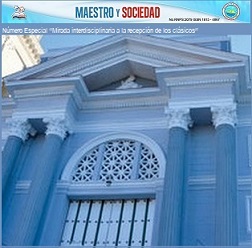The female characters in Cayo Graco, a tragedy translated by José María Heredia
Array
Keywords:
Classical history, theater, symbologyAbstract
His article aims to investigate the use of classical history in the elaboration of a nineteenth-century historiographic discourse. The Cuban José María Heredia, poet, journalist, narrator, critic and playwright was also part of the nineteenth-century historians with the publication in Cuba of his book Lessons in Universal History; written between 1831 and 1832 and, to grant him the status of historian. Focused on the events of the war of independence of his native homeland he found in the symbology of ancient history a political civic repertoire through written, educational, performative and symbolic discursive practices. Like other historians of the first half of the 19th century, they try to understand classical history as part of the history of mankind and elaborate a comparative history to understand universal and local historical processes.
References
2. Bueno, S. (1963). Historia de la Literatura Cubana. La Habana: Editora del Ministerio de Educación.
3. Durán R., G. y Suárez P., V. (2003). Ecología y Poesía: Apuntes en torno al poema “El Niágara” de José María Heredia. Toluca, México: Concurso Internacional por el Bicentenario del Natalicio de José María Heredia.
4. Henríquez U., M. (1978). Panorama histórico de la literatura cubana. La Habana: Editorial Arte y Literatura.
5. Heredia H., J. M. (2003). Obra Poética. La Habana: Editorial Letras Cubanas, Instituto Cubano del Libro.
6. Heredia H., J. M. (2005). Epistolario de José María Heredia. La Habana: Editorial Letras Cubanas.
7. Heredia H., J. M. (1879). Cayo Graco. Habana: Imprenta Militar de la Vda. de Soler y Compañía.
8. Instituto de Literatura y Lingüística de la Academia de Ciencias de Cuba. (1975). Diccionario de la Literatura Cubana. La Habana: Editorial Letras Cubanas.
9. Instituto de Literatura y Lingüística de la Academia de Ciencias de Cuba. (1983). Perfil histórico de las letras cubanas desde los orígenes hasta 1898. La Habana: Editorial Letras Cubanas.
10. Instituto de Literatura y Lingüística “José Antonio Portuondo Valdor”. (2002). Historia de la Literatura Cubana. La Colonia: Desde los Orígenes hasta 1898. (t. I.). La Habana: Instituto Cubano del Libro.
11. Plutarco. (1822). Vidas paralelas. (s. l.): Imprenta Nacional.
Downloads
Published
How to Cite
Issue
Section
License
This journal provides immediate open access to its content, based on the principle that offering the public free access to research helps a greater global exchange of knowledge. Each author is responsible for the content of each of their articles.



























 Universidad de Oriente
Universidad de Oriente 